Yeni Medya Sanatında Akışkan Gerçeklik...
Derya Yücel & Una Popovic
İstanbul-Belgrad, Nisan 2014
Yaratıcı pratikler tarihi boyunca çoğunlukla “gerçek”liğin yorumlanması, yeniden yaratılması ve insan imgeleminin bulanık yapılarının bir araştırması oldu. Dünya kendini bize, sanatçıların uzun zaman bir yüzeye yansıttığı bu kurguların ışığında gösterdi. Geleneksel sanat etkinliği gerçeğin tasarımlanması olsa da günümüzde yeni dijital teknolojilerin sunduğu düzenekler sanat yapıtının kendisini gerçekliğin bir simülasyonu haline getirdi. Dijital mecralar yalnızca gündelik yaşamı değil sanatsal, kültürel ve toplumsal ufkumuzu büyük ölçüde genişletti. Ancak bu yoğun veri akışı ve enformasyon kargaşası arasında “gerçek”le algısal iletişimimizi yitirmek çoğu zaman ödediğimiz bir bedel haline geldi. Bugün, teknoloji (d)evrimi, bireysel ve toplumsal gerçekliğin ortak sorgulamasında yeni araçlar öneriyor ve yeni medyanın bu araçları kullanma stratejileri de geleceğin sanat algısı üzerine ipuçları veriyor. Peki, sanat hala gerçekliğin/hakikatin tekrardan sunumu, temsili, ikamesi olabilir mi? Gerçeklik yorumu sanat yapıtları tarafından nesneleştirilse de, bugün katı bir forma sabitlenemez bir gerçeklik deneyiminden bahsedemez miyiz? Bugün dijital kültür ortamında bilgi, imge ve temsilin anlamı sanatı nasıl dönüştürmekte?
Formsuz: Yeni Medya Sanatında Akışkan Gerçeklik başlıklı etkinlik, bu minvalde önümüze gelen soruları sıralamak ve yeni medya sanatının bu sorulara birer cevap olmasa da getireceği önerileri araştırmak amacını taşımakta. Başlığını, Georges Bataille’ın kuramlaştırdığı “L’informe/formless” kavramından alan sergi, yeni medya sanatı dahilinde değişken sınırların değişen konumlarına, Sırbistan ve Türkiye’den katılan sanatçıların üretimleri üzerinden odaklanıyor. Bu bağlamda, “Formsuz” kavramı hem günümüz dünyasını hem de günümüz sanatını tarif edebilecek anlamlı bir metafor olarak öne çıkıyor. Bataille’da bu kavram, şeyleri olumsuzlayan ya da biçim yoksunluğuna vurgu yapan bir sıfat değil, biçim ve içerik arasındaki yıkıcı bir ikilik olarak anılmıştı. Herşey kendine dair bir forma zaten sahipti, solucan, örümcek, tükürük hatta evren bile değişken formsuzluğuyla bir biçim olarak özgürleştirici bir metafor olabilirdi. Bataille, formsuz’u her türlü kategoriyi bozmanın yeni bir yolu olarak görmüştü. Biz de, medya sanatı üretimlerini “formsuz” kavramı üzerinden okumak için çok çeşitli yollara sahip olabileceğimize inanıyoruz. Öyle ki, günümüz dünyasının kargaşa ve düzensizliği içinde, yapısı bozulmuş, koordinatlarını yitirmiş, akışkan bir deneyime dönüşen gerçeklik algımızın sanatçılar tarafından birer yeni medya formuna dönüştüğünü izliyoruz. Tıpkı “formsuz” kavramında olduğu gibi yeni medya sanatının da zaman/mekan/biçim/içerik bağlamlarına dair değişken, akışkan ve sabitlenemez formlara imkan verdiğini gözlemliyoruz. Yeni medya sanatlarının gündelik fenomenlerle yakın ilişkisi, bu tip sanat üretimlerinin kültürel perspektiften ele alınmasının kaçınılmaz olduğunu bize kanıtlıyor. Dijital teknolojilerin aracı ya da ortamı olduğu sanat üretimlerinde ilgi daha çok biçim/temsil üzerine değil, deneyim/algı üzerine işlemekte hatta, Bataille’in de çok öncesinde ileri sürdüğü gibi sanat, bir “sınıraşma” refleksi olarak kendini göstermekte.
Akışkan Sınırlar...
Sanatta geleneksel kategorilerin sınırları, teknolojinin kullanılması ile gittikçe farklı bir boyut kazandı. Sanatçı kimliği, izleyicinin rolü, sanat yapıtının gerçekliği, disiplinler ve form-içerik gibi katı kategorilerle sınırlanamaz olan günümüz sanatı, değişebilir, kolektif, işbirliğine dayalı, saydam ve esnek ölçütlere evrildi.
Yirminci yüzyılın başında Modern Sanat, sanatçı kimliğine, sanatsal gerçekliğe ve onun temsiliyetine yapılan atıfları yeniden tanımladı. Sanat, nesne dünyasının temsiliyetini soyutlayarak ya da yerine nesnenin kendisini koyarak yeni bir tür gerçekliği benimsedi. Sanat nesnesinin yeniden tanımlanmasına aracılık eden sanatçılar, yaratıcı edimi sanatçının tek başına gerçekleştirmediğini, izleyicinin, yapıtın içsel özelliklerini deşifde edip yorumlayarak yaratıcı edime katkıda bulunduğunu haber vermişti. Eylem ve izleyicinin katılımı önce Kinetik sanat ve Op-Art’la sonra Fluxus, Happening, Performans ve Yeni Gerçekçilik’te önemli bir rol oynamıştı. İzleyicinin rolü aslında bir kaç aşamada dönüştü; edilgen, aktör, etkin ve ortak yaratımlı katılımcı. Yeni medya sanatıysa izleyici ile sanat yapıtı arasındaki etkileşimi karşılıklı etki biçiminde yerleştirdi. İzleyici artık sanat yapıtının kurulmasına, tasarımına, içerik ve davranışına etkin olarak katılan kullanıcılara, dolayısıyla tüketici artık üreticiye dönüştü. Bu yaklaşımda alıcı kişi yaratıcı edimin ayrılmaz bir parçası haline geldi. İzleyicinin alanı ve etkisi genişledi. Sanatçı ve izleyicinin davranış kodları değişken, sanatçı-yapıt-izleyici kimlikleri arasındaki sınırlar akışkan bir forma büründü.
Dijital teknolojiler, sanatçıya sanat yapıtının uzamsal kimliğini genişleten yeni yöntem ve paradigalar sundu. Bu olanak, yalnızca yapıt/imge açısından değil izleyici-yapıt arasındaki etkileşim alanını da genişletti. Gerçek dünyanın hem algısal hem duyusal koordinatları sanal uzamın sonsuzluğuna yol almaya başladı. Yeni medyanın içerdiği geçişlilik, yalnızca sanatsal anlatım biçimlerini değil, üretim araçlarını da çeşitlendirdi. Öyle ki, birler ve sıfırlar topluluğu olarak duran bir veri formu üç boyutlu modelleme ve animasyon yazılımıyla yaratılan bir sanal nesneye, -animasyon olarak- hareketli bir görüntüden -heykel/resim olarak- fiziksel bir forma bürünüyor. Animasyon ya da görüntü, internet ağında dolaşıma girerek -net sanatı- var olabiliyor. Bugün, yeni medya sanatı, geleneksel kategorilere ait kavramları analiz etmek yerine onları birbirine bulaştırmakta daha hevesli davranmakta. Sanatçıların stratejileri, ‘gerçek’liğin kestirilemez doğasına vurgu yaparcasına onu manipüle etme ve sanatın özerk rolünü sorgulama üzerine işlemekte. Sanatçılar, esnek formların üretimi, hızlı veri akışına dahiliyet, anlık enformasyona açıklık, refleksif örgütlenme ve katılım gibi pratiklerle ilerleyen bir dili benimsemekte. Dijital dünyada gerçeğin sanatsal olarak incelenmesi, “akışkan gerçekliğin” barındırdığı sınırların, tuzakların ve olanakların sorgulanmasının bir yoludur. Bu anlamda, yeni sanat bir medya ekolojisi olarak tanımlanabilir.
Sergi üzerine kısa bir kılavuz...
Ansen, dijital araçları kullanarak oluşturduğu “Cusei/Biat” isimli mono-C print çalışmasında, heykel, resim, fotoğraf ve sinema prensiplerini kaynaştırarak gündelik nesneleri dönüştürüyor. Kurguladığı bu kompozisyon, savaş, adalet ve suç kavramları, edebiyat, din ve tarih prensipleri üzerine temelleniyor. Ağıtsal bir özeleştiriyi ironik bir forma dönüştüren Barış Mengütay’ın “Bizimoğlan” isimli dijital animasyonu aynı zamanda dijital bir imge olarak da sergide yerini alıyor. Dijital tekniklerle yaratılan bu grotesk imge, formlar arasındaki geçişliliğe de vurgu yapıyor. Dejan Grba, ilk olarak video ve fotoğraf biçimlerinde hayata geçirdiği “Alibi (Black or White)” isimli transmedya projesinde Michael Jackson’ın bir video klibini kullanıyor. Bu görsel-kinestezik-ses kaydı; yüz morfolojisinin, yüz morfolojisinden yola çıkarak portrenin estetik açılımları, kimliklerin yorumlanması ve gerçeğin sanal doğasının tezahürlerinin yaratıcı metodolojinin potansiyelini açığa çıkarıyor. Dorijan Kolund&2;ija,“Michelangelo” isimli dijital animasyonunda, Michelangelo’nun “Kıyamet Günü” freskini “harekete geçirerek” sürekli bir hareket dizisine dönüştürüyor ve izleyicisine gerçek ve kurgusal mekân arasında yaratılan bir alan sunuyor. Elif Öner ve Vincent Rozenberg’in ortak çalışması www.historicalfuturemuseum.org, bir net-art projesi olarak izleniyor. Sanatçılar, her güne ait bir imgeyi sosyal medya üzerinden paylaşıyor ve siteye yüklüyor. Bir yıla yayılacak bu proje ilk bakışta kişisel bir günlük gibi izlenirken aynı zamanda sanat pratiği, gündelik yaşam ve tarih arasındaki arşiv ilişkileri üzerine bir okuma öneriyor. Gizem Karakaş, ‘Fuat Eşrefoğlu Eating A Lahmacun’ adlı kısa filmi ile yeni medya deneyimden besleniyor. Sanatta özgünlükten çok samimiyete inanan sanatçı, Jørgen Leth’in 1982 tarihli filmi ‘Andy Warhol Eating A Hamburger’i yerel öğelerle yeniden üretiyor. Nemanja Ladic, izleyici mütemadiyen hareket halindeyken birbirini izleyen manzaralardan oluşan “Papierschnitzel” başlıklı video çalışmasıyla seyahat halinde yakalanması muhtemel görsel bir içeriğe işaret ediyor. Hareketli bir sahne tasarımına benzer şekilde, Ladic’in eseri zaman nosyonunu, zaman nosyonu aracılığıyla izlemek ve görmek arasındaki ilişkiye değiniyor. Çeşitli temsilleri bir araya getiren sanatçı, kasıtlı olarak her birini diğerinin altına kaydırıyor ve böylelikle görsellerin bir araya getirilmesi fikrinin yüzeyselliğine vurgu yapıyor. Medya çalışmalarında, yeni dijital araçları, algoritmaları ve üretimsel dilbilgisi programlama dillerini kullanan Ozan Türkkan, sergide “Delik” isimli kaleydoskopik generative video yerleştirmesi ile yer alıyor. Sanatçı, kuantum evreninin fraktal boyutları ile bizim aramızda bir delik açıyor. İzleyici, metal çokgen bir kütlede açılmış delikten içeriye baktığında makro bir evren ile karşılaşıyor. Birey, toplum, teknoloji ve doğa arasındaki ilişkiyi, hazırlanması yıllar süren ve transmedya mekân enstalasyonlarına işaret eden “Self-sustaining Systems of Absurdity” (sergide enstalasyonların ve önceki sergilerin dokümantasyonu yer alacak) başlıklı çalışmasıyla keşfetmeye girişen Stevan Kojic, kullandığı elektronik atıklarla, alternatif bir biyo-sosyal yaşam potansiyelini ve yaşayan organizmanlarla makine sistemleri arasındaki ilişkiyi inceliyor. Dijital ve geleneksel yöntemler arasındaki karşılıklı ilişki ve gerilim üzerine üreten Yağız Özgen çalışmalarında dijital dilin doğasını geleneksel sanat üretim biçimlerine simüle ediyor. Bir aydınlatma aparatının soyut bir forma bürünen detayının izlendiği “isimsiz”de resmin basit ilkelerini dijital dilin süreksiz yapısı üzerinde inşa ediyor. Yetkin Yılmaz ve Ahmet Said Kaplan’nın birlikte çalıştıkları DECOL sanat kolektifi tarafından tasarlanan “Zamanın Fotoğrafı” adlı interaktif yerleştirme, uzay-zaman kavramlarını birbirine karıştırmayı amaçlıyor. Sanatçı, slit-scan tekniğini gerçek zamanlı uygulayarak uzay-zaman üzerine bir tartışma ortamı yaratırken, kendi görüntüsü önce ve şimdi olarak ekranda yansıyan izleyicinin gerçeklik algısı manipüle ediliyor. Gerçekliği kolajlarıyla dönüştürdüğü bir dil benimseyen Zorica Colic sergiye iki ayrı çalışması ile katılıyor. Sanatçının “Çağdaş Avrupa”da simetrik ve asimetrik toplumsal / kültürel kimlikler arasındaki ilişkiyi değerlendirdiği “AnOther World of Interiors” isimli kolajı, kimliğe dair büyük ve üst söylemlerin marjlarını görselleştiriyor. Sanatçının, sergide yer alan diğer bir çalışması “Face Shifting” ise kimlik, beden, reklam, medya ve teknoloji kavramları üzerine bir araştırma sunuyor. Kitlesel rollerin dayatılması, beğeni-tüketim kültürünün içselleştirilmesi, doğal ve yapay arasındaki sınırların erimesi sanatçının ilgi alanını oluşturuyor.
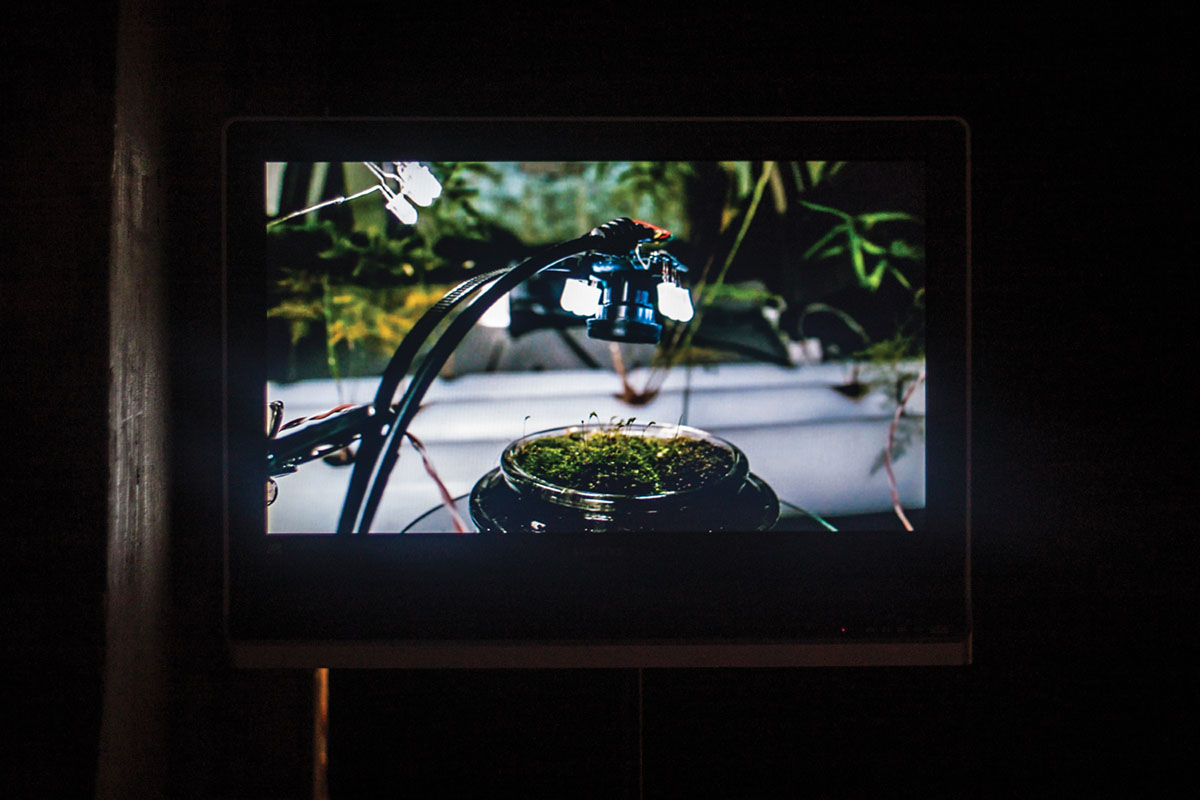
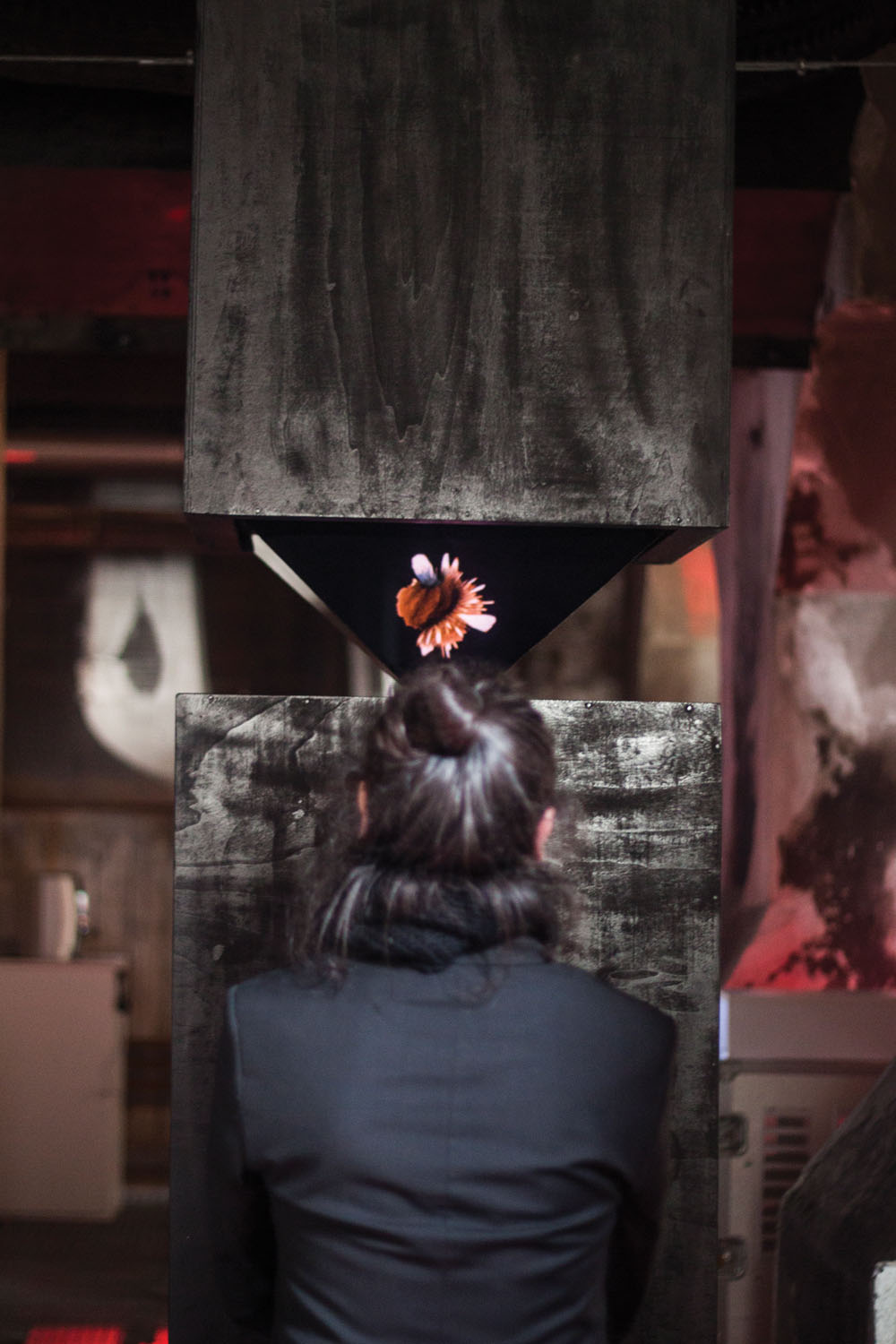
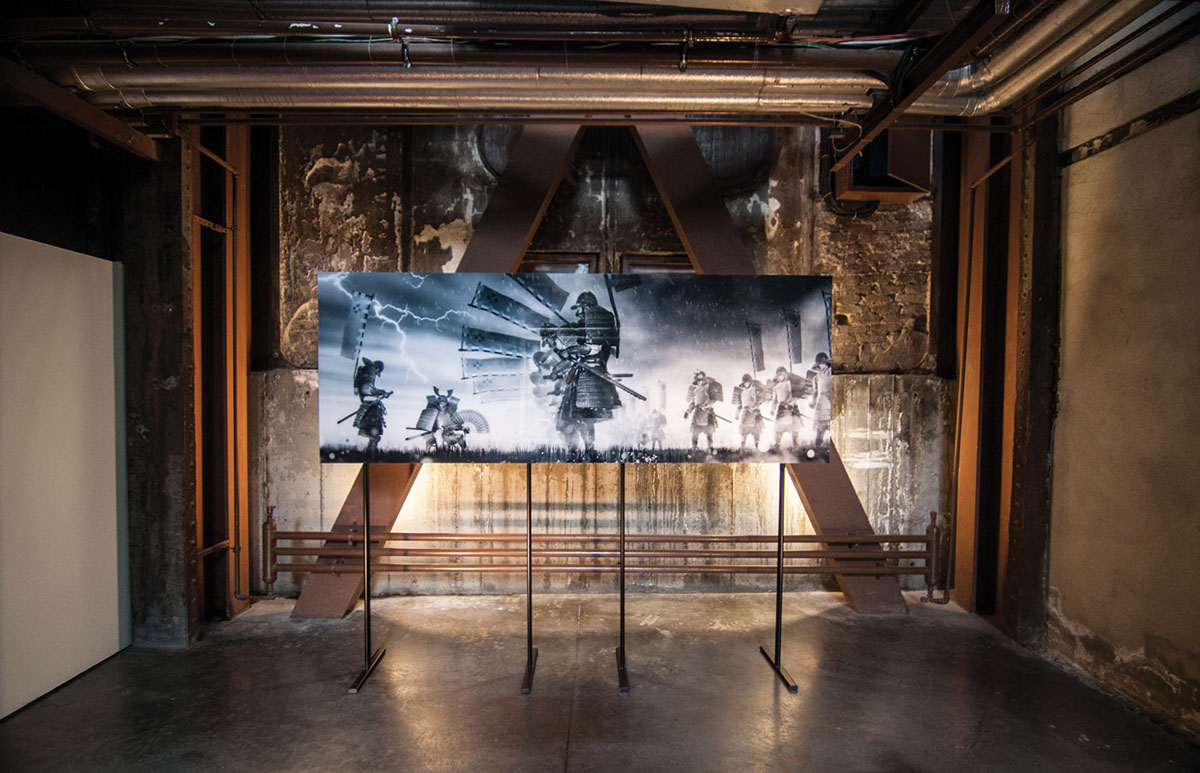
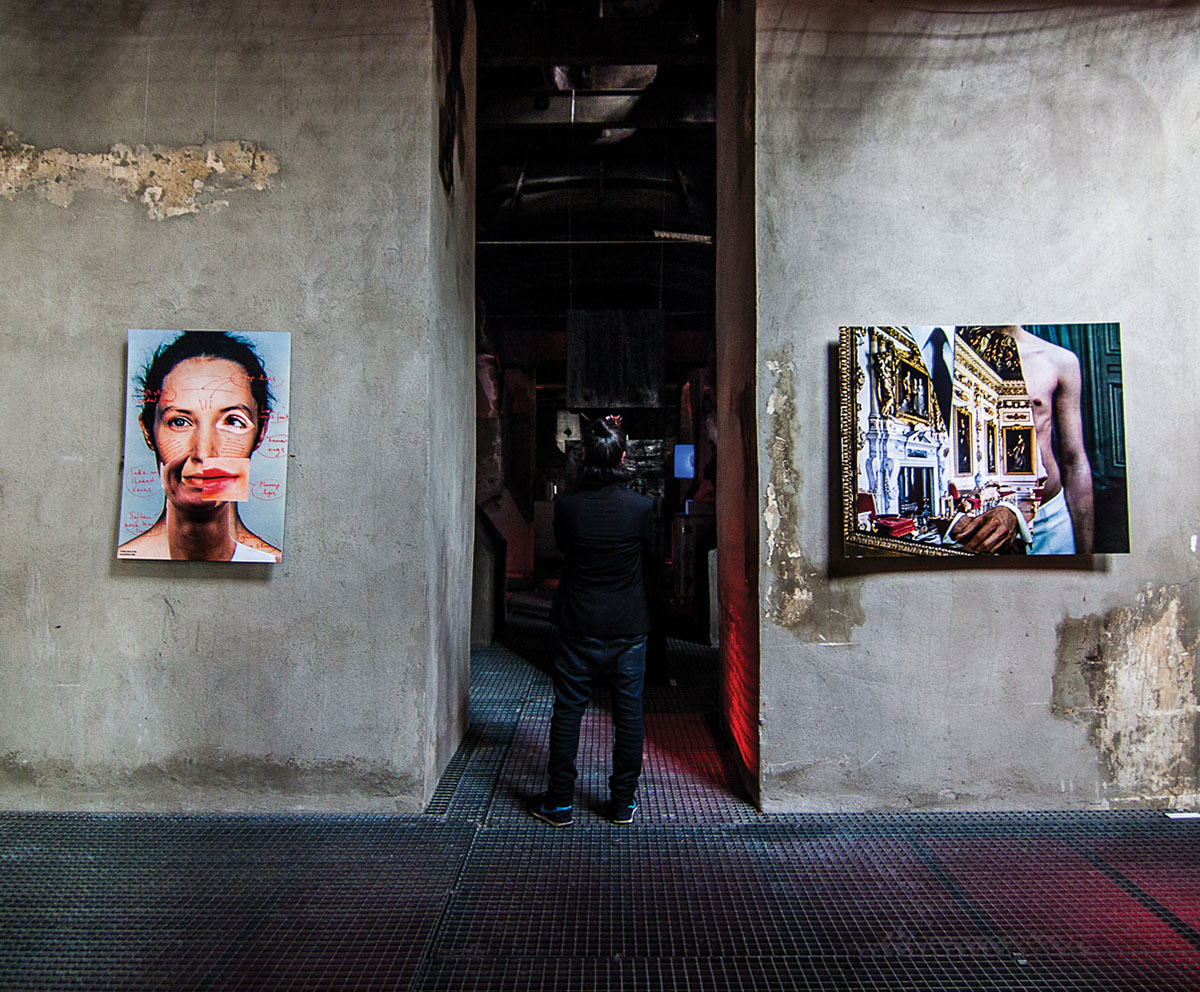
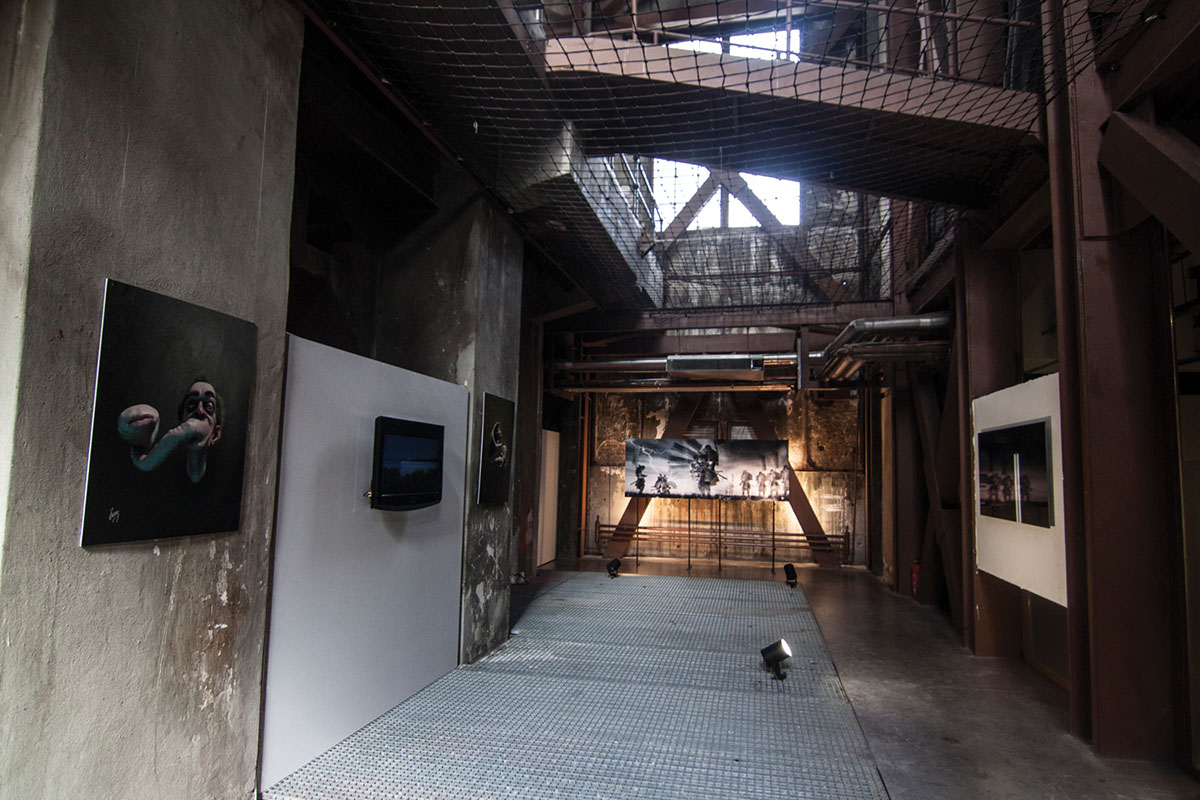
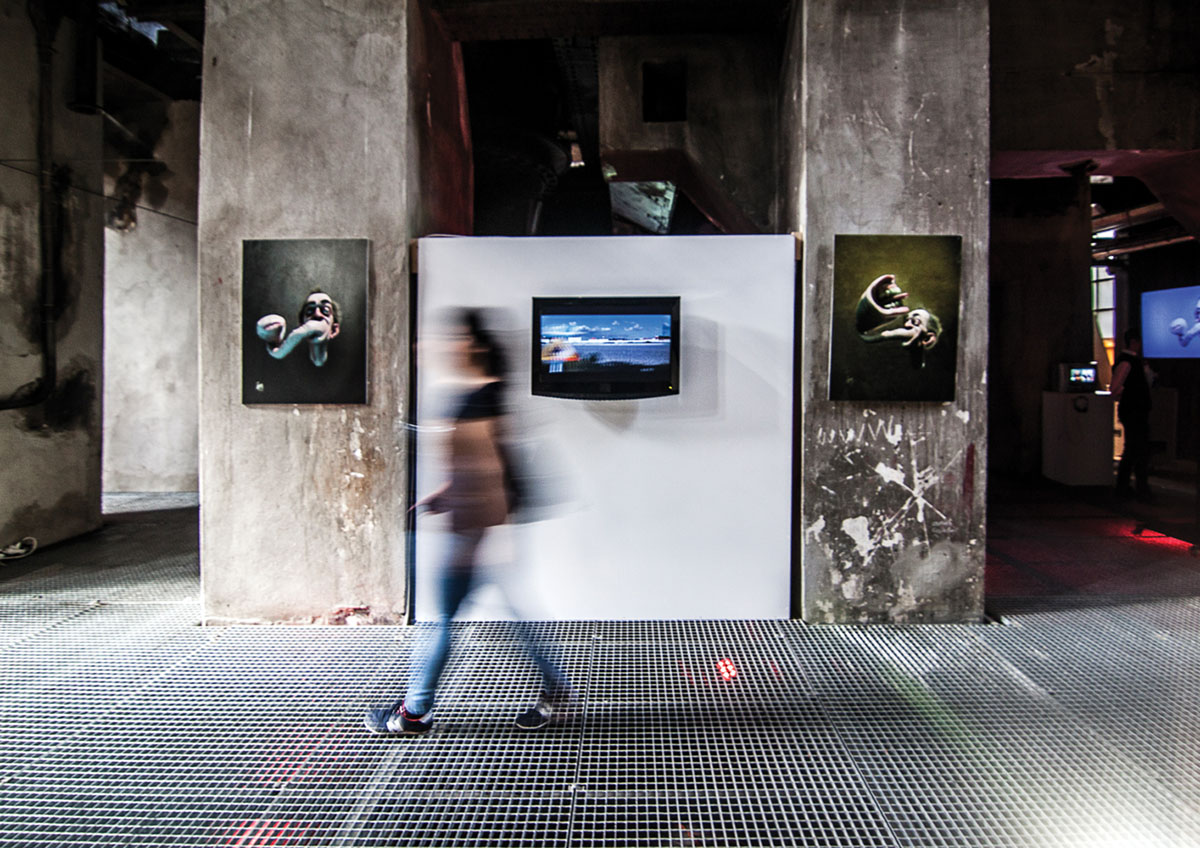
Derya Yücel & Una Popovic
İstanbul-Belgrad, Nisan 2014
Yaratıcı pratikler tarihi boyunca çoğunlukla “gerçek”liğin yorumlanması, yeniden yaratılması ve insan imgeleminin bulanık yapılarının bir araştırması oldu. Dünya kendini bize, sanatçıların uzun zaman bir yüzeye yansıttığı bu kurguların ışığında gösterdi. Geleneksel sanat etkinliği gerçeğin tasarımlanması olsa da günümüzde yeni dijital teknolojilerin sunduğu düzenekler sanat yapıtının kendisini gerçekliğin bir simülasyonu haline getirdi. Dijital mecralar yalnızca gündelik yaşamı değil sanatsal, kültürel ve toplumsal ufkumuzu büyük ölçüde genişletti. Ancak bu yoğun veri akışı ve enformasyon kargaşası arasında “gerçek”le algısal iletişimimizi yitirmek çoğu zaman ödediğimiz bir bedel haline geldi. Bugün, teknoloji (d)evrimi, bireysel ve toplumsal gerçekliğin ortak sorgulamasında yeni araçlar öneriyor ve yeni medyanın bu araçları kullanma stratejileri de geleceğin sanat algısı üzerine ipuçları veriyor. Peki, sanat hala gerçekliğin/hakikatin tekrardan sunumu, temsili, ikamesi olabilir mi? Gerçeklik yorumu sanat yapıtları tarafından nesneleştirilse de, bugün katı bir forma sabitlenemez bir gerçeklik deneyiminden bahsedemez miyiz? Bugün dijital kültür ortamında bilgi, imge ve temsilin anlamı sanatı nasıl dönüştürmekte?
Formsuz: Yeni Medya Sanatında Akışkan Gerçeklik başlıklı etkinlik, bu minvalde önümüze gelen soruları sıralamak ve yeni medya sanatının bu sorulara birer cevap olmasa da getireceği önerileri araştırmak amacını taşımakta. Başlığını, Georges Bataille’ın kuramlaştırdığı “L’informe/formless” kavramından alan sergi, yeni medya sanatı dahilinde değişken sınırların değişen konumlarına, Sırbistan ve Türkiye’den katılan sanatçıların üretimleri üzerinden odaklanıyor. Bu bağlamda, “Formsuz” kavramı hem günümüz dünyasını hem de günümüz sanatını tarif edebilecek anlamlı bir metafor olarak öne çıkıyor. Bataille’da bu kavram, şeyleri olumsuzlayan ya da biçim yoksunluğuna vurgu yapan bir sıfat değil, biçim ve içerik arasındaki yıkıcı bir ikilik olarak anılmıştı. Herşey kendine dair bir forma zaten sahipti, solucan, örümcek, tükürük hatta evren bile değişken formsuzluğuyla bir biçim olarak özgürleştirici bir metafor olabilirdi. Bataille, formsuz’u her türlü kategoriyi bozmanın yeni bir yolu olarak görmüştü. Biz de, medya sanatı üretimlerini “formsuz” kavramı üzerinden okumak için çok çeşitli yollara sahip olabileceğimize inanıyoruz. Öyle ki, günümüz dünyasının kargaşa ve düzensizliği içinde, yapısı bozulmuş, koordinatlarını yitirmiş, akışkan bir deneyime dönüşen gerçeklik algımızın sanatçılar tarafından birer yeni medya formuna dönüştüğünü izliyoruz. Tıpkı “formsuz” kavramında olduğu gibi yeni medya sanatının da zaman/mekan/biçim/içerik bağlamlarına dair değişken, akışkan ve sabitlenemez formlara imkan verdiğini gözlemliyoruz. Yeni medya sanatlarının gündelik fenomenlerle yakın ilişkisi, bu tip sanat üretimlerinin kültürel perspektiften ele alınmasının kaçınılmaz olduğunu bize kanıtlıyor. Dijital teknolojilerin aracı ya da ortamı olduğu sanat üretimlerinde ilgi daha çok biçim/temsil üzerine değil, deneyim/algı üzerine işlemekte hatta, Bataille’in de çok öncesinde ileri sürdüğü gibi sanat, bir “sınıraşma” refleksi olarak kendini göstermekte.
Akışkan Sınırlar...
Sanatta geleneksel kategorilerin sınırları, teknolojinin kullanılması ile gittikçe farklı bir boyut kazandı. Sanatçı kimliği, izleyicinin rolü, sanat yapıtının gerçekliği, disiplinler ve form-içerik gibi katı kategorilerle sınırlanamaz olan günümüz sanatı, değişebilir, kolektif, işbirliğine dayalı, saydam ve esnek ölçütlere evrildi.
Yirminci yüzyılın başında Modern Sanat, sanatçı kimliğine, sanatsal gerçekliğe ve onun temsiliyetine yapılan atıfları yeniden tanımladı. Sanat, nesne dünyasının temsiliyetini soyutlayarak ya da yerine nesnenin kendisini koyarak yeni bir tür gerçekliği benimsedi. Sanat nesnesinin yeniden tanımlanmasına aracılık eden sanatçılar, yaratıcı edimi sanatçının tek başına gerçekleştirmediğini, izleyicinin, yapıtın içsel özelliklerini deşifde edip yorumlayarak yaratıcı edime katkıda bulunduğunu haber vermişti. Eylem ve izleyicinin katılımı önce Kinetik sanat ve Op-Art’la sonra Fluxus, Happening, Performans ve Yeni Gerçekçilik’te önemli bir rol oynamıştı. İzleyicinin rolü aslında bir kaç aşamada dönüştü; edilgen, aktör, etkin ve ortak yaratımlı katılımcı. Yeni medya sanatıysa izleyici ile sanat yapıtı arasındaki etkileşimi karşılıklı etki biçiminde yerleştirdi. İzleyici artık sanat yapıtının kurulmasına, tasarımına, içerik ve davranışına etkin olarak katılan kullanıcılara, dolayısıyla tüketici artık üreticiye dönüştü. Bu yaklaşımda alıcı kişi yaratıcı edimin ayrılmaz bir parçası haline geldi. İzleyicinin alanı ve etkisi genişledi. Sanatçı ve izleyicinin davranış kodları değişken, sanatçı-yapıt-izleyici kimlikleri arasındaki sınırlar akışkan bir forma büründü.
Dijital teknolojiler, sanatçıya sanat yapıtının uzamsal kimliğini genişleten yeni yöntem ve paradigalar sundu. Bu olanak, yalnızca yapıt/imge açısından değil izleyici-yapıt arasındaki etkileşim alanını da genişletti. Gerçek dünyanın hem algısal hem duyusal koordinatları sanal uzamın sonsuzluğuna yol almaya başladı. Yeni medyanın içerdiği geçişlilik, yalnızca sanatsal anlatım biçimlerini değil, üretim araçlarını da çeşitlendirdi. Öyle ki, birler ve sıfırlar topluluğu olarak duran bir veri formu üç boyutlu modelleme ve animasyon yazılımıyla yaratılan bir sanal nesneye, -animasyon olarak- hareketli bir görüntüden -heykel/resim olarak- fiziksel bir forma bürünüyor. Animasyon ya da görüntü, internet ağında dolaşıma girerek -net sanatı- var olabiliyor. Bugün, yeni medya sanatı, geleneksel kategorilere ait kavramları analiz etmek yerine onları birbirine bulaştırmakta daha hevesli davranmakta. Sanatçıların stratejileri, ‘gerçek’liğin kestirilemez doğasına vurgu yaparcasına onu manipüle etme ve sanatın özerk rolünü sorgulama üzerine işlemekte. Sanatçılar, esnek formların üretimi, hızlı veri akışına dahiliyet, anlık enformasyona açıklık, refleksif örgütlenme ve katılım gibi pratiklerle ilerleyen bir dili benimsemekte. Dijital dünyada gerçeğin sanatsal olarak incelenmesi, “akışkan gerçekliğin” barındırdığı sınırların, tuzakların ve olanakların sorgulanmasının bir yoludur. Bu anlamda, yeni sanat bir medya ekolojisi olarak tanımlanabilir.
Sergi üzerine kısa bir kılavuz...
Ansen, dijital araçları kullanarak oluşturduğu “Cusei/Biat” isimli mono-C print çalışmasında, heykel, resim, fotoğraf ve sinema prensiplerini kaynaştırarak gündelik nesneleri dönüştürüyor. Kurguladığı bu kompozisyon, savaş, adalet ve suç kavramları, edebiyat, din ve tarih prensipleri üzerine temelleniyor. Ağıtsal bir özeleştiriyi ironik bir forma dönüştüren Barış Mengütay’ın “Bizimoğlan” isimli dijital animasyonu aynı zamanda dijital bir imge olarak da sergide yerini alıyor. Dijital tekniklerle yaratılan bu grotesk imge, formlar arasındaki geçişliliğe de vurgu yapıyor. Dejan Grba, ilk olarak video ve fotoğraf biçimlerinde hayata geçirdiği “Alibi (Black or White)” isimli transmedya projesinde Michael Jackson’ın bir video klibini kullanıyor. Bu görsel-kinestezik-ses kaydı; yüz morfolojisinin, yüz morfolojisinden yola çıkarak portrenin estetik açılımları, kimliklerin yorumlanması ve gerçeğin sanal doğasının tezahürlerinin yaratıcı metodolojinin potansiyelini açığa çıkarıyor. Dorijan Kolund&2;ija,“Michelangelo” isimli dijital animasyonunda, Michelangelo’nun “Kıyamet Günü” freskini “harekete geçirerek” sürekli bir hareket dizisine dönüştürüyor ve izleyicisine gerçek ve kurgusal mekân arasında yaratılan bir alan sunuyor. Elif Öner ve Vincent Rozenberg’in ortak çalışması www.historicalfuturemuseum.org, bir net-art projesi olarak izleniyor. Sanatçılar, her güne ait bir imgeyi sosyal medya üzerinden paylaşıyor ve siteye yüklüyor. Bir yıla yayılacak bu proje ilk bakışta kişisel bir günlük gibi izlenirken aynı zamanda sanat pratiği, gündelik yaşam ve tarih arasındaki arşiv ilişkileri üzerine bir okuma öneriyor. Gizem Karakaş, ‘Fuat Eşrefoğlu Eating A Lahmacun’ adlı kısa filmi ile yeni medya deneyimden besleniyor. Sanatta özgünlükten çok samimiyete inanan sanatçı, Jørgen Leth’in 1982 tarihli filmi ‘Andy Warhol Eating A Hamburger’i yerel öğelerle yeniden üretiyor. Nemanja Ladic, izleyici mütemadiyen hareket halindeyken birbirini izleyen manzaralardan oluşan “Papierschnitzel” başlıklı video çalışmasıyla seyahat halinde yakalanması muhtemel görsel bir içeriğe işaret ediyor. Hareketli bir sahne tasarımına benzer şekilde, Ladic’in eseri zaman nosyonunu, zaman nosyonu aracılığıyla izlemek ve görmek arasındaki ilişkiye değiniyor. Çeşitli temsilleri bir araya getiren sanatçı, kasıtlı olarak her birini diğerinin altına kaydırıyor ve böylelikle görsellerin bir araya getirilmesi fikrinin yüzeyselliğine vurgu yapıyor. Medya çalışmalarında, yeni dijital araçları, algoritmaları ve üretimsel dilbilgisi programlama dillerini kullanan Ozan Türkkan, sergide “Delik” isimli kaleydoskopik generative video yerleştirmesi ile yer alıyor. Sanatçı, kuantum evreninin fraktal boyutları ile bizim aramızda bir delik açıyor. İzleyici, metal çokgen bir kütlede açılmış delikten içeriye baktığında makro bir evren ile karşılaşıyor. Birey, toplum, teknoloji ve doğa arasındaki ilişkiyi, hazırlanması yıllar süren ve transmedya mekân enstalasyonlarına işaret eden “Self-sustaining Systems of Absurdity” (sergide enstalasyonların ve önceki sergilerin dokümantasyonu yer alacak) başlıklı çalışmasıyla keşfetmeye girişen Stevan Kojic, kullandığı elektronik atıklarla, alternatif bir biyo-sosyal yaşam potansiyelini ve yaşayan organizmanlarla makine sistemleri arasındaki ilişkiyi inceliyor. Dijital ve geleneksel yöntemler arasındaki karşılıklı ilişki ve gerilim üzerine üreten Yağız Özgen çalışmalarında dijital dilin doğasını geleneksel sanat üretim biçimlerine simüle ediyor. Bir aydınlatma aparatının soyut bir forma bürünen detayının izlendiği “isimsiz”de resmin basit ilkelerini dijital dilin süreksiz yapısı üzerinde inşa ediyor. Yetkin Yılmaz ve Ahmet Said Kaplan’nın birlikte çalıştıkları DECOL sanat kolektifi tarafından tasarlanan “Zamanın Fotoğrafı” adlı interaktif yerleştirme, uzay-zaman kavramlarını birbirine karıştırmayı amaçlıyor. Sanatçı, slit-scan tekniğini gerçek zamanlı uygulayarak uzay-zaman üzerine bir tartışma ortamı yaratırken, kendi görüntüsü önce ve şimdi olarak ekranda yansıyan izleyicinin gerçeklik algısı manipüle ediliyor. Gerçekliği kolajlarıyla dönüştürdüğü bir dil benimseyen Zorica Colic sergiye iki ayrı çalışması ile katılıyor. Sanatçının “Çağdaş Avrupa”da simetrik ve asimetrik toplumsal / kültürel kimlikler arasındaki ilişkiyi değerlendirdiği “AnOther World of Interiors” isimli kolajı, kimliğe dair büyük ve üst söylemlerin marjlarını görselleştiriyor. Sanatçının, sergide yer alan diğer bir çalışması “Face Shifting” ise kimlik, beden, reklam, medya ve teknoloji kavramları üzerine bir araştırma sunuyor. Kitlesel rollerin dayatılması, beğeni-tüketim kültürünün içselleştirilmesi, doğal ve yapay arasındaki sınırların erimesi sanatçının ilgi alanını oluşturuyor.





